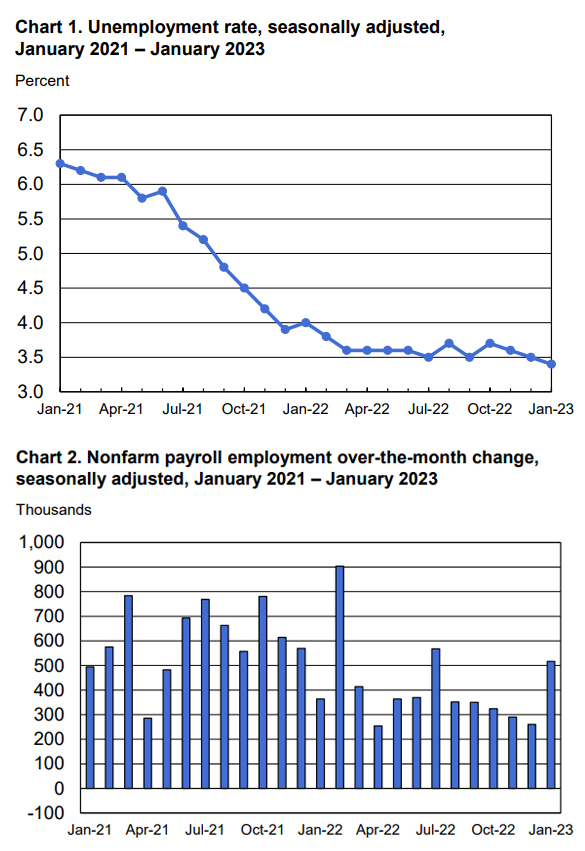The labor market remains historically tight. On Wednesday, the Labor Department noted U.S. employers had 11 million job openings at year-end, 600,000 more than the prior month. Today’s U.S. Bureau of Labor Statistics (BLS) January jobs survey reinforced that data point, reporting a surprisingly robust gain of 517,000 non-farm jobs. Both the unemployment rate, at 3.4 percent, and the number of unemployed persons, at 5.7 million, changed little in January versus the prior month. However, with the slight decrease in unemployment, the jobless level is at its lowest since May 1969.

It is worth noting that January’s employment report includes its annual “benchmark” revisions and updates to formulas used to smooth seasonal fluctuation data in the establishment survey. It also incorporates new population estimates in the household survey, which makes January’s unemployment data somewhat difficult to compare to December’s results.
“The BLS monthly employment report continues to report solid job growth in the face of growing economic headwinds. Executive recruiters throughout our MRINetwork of over 250 offices also see consistent client demand for top talent to drive organizational goals,” noted Nancy Halverson vice president, MRINetwork. “But our top performing clients are looking beyond month-to-month talent needs as they strategically address the challenges of economic headwinds, balancing onsite versus remote working, and controlling costs while still growing the business. Our consultants help these forward-looking clients to focus on creating and maintaining a strong hiring brand and company culture. We challenge business leaders to strengthen the interview process, improve candidate communication touch points, enhance negotiation tactics, and establish robust employee onboarding processes. Organizations not willing to disrupt their talent acquisition strategies will struggle to thrive in the new world of work.”
Federal Reserve Chair Jerome Powell, suggesting that the Fed’s effort to cool inflation appears to be working so far, told reporters following their Wednesday meeting, “It is a good thing that the disinflation that we have seen so far has not come at the expense of a weaker labor market, despite the slowdown in growth, the labor market remains extremely tight.” It remains to be seen if the robust January BLS jobs report changes his viewpoint.
Characterizing the surprising BLS report Daniel Zhao, lead economist for job review site Glassdoor noted, “Today’s report is an echo of 2022’s surprisingly resilient job market, beating back recession fears, the Fed has a New Year’s resolution to cool down the labor market, and so far, the labor market is pushing back.”
Total nonfarm payroll employment rose by 517,000 in January, compared with an average monthly gain of 401,000 in 2022 and well above analysts’ expectations.
Leisure and hospitality added 128,000 jobs in January compared with an average of 89,000 jobs per month in 2022. Over the month, food services and drinking places added 99,000 jobs, while employment continued to trend up in accommodation (+15,000).
In January, employment in professional and business services rose by 82,000, led by gains in professional, scientific, and technical services (+41,000).
Healthcare added 58,000 jobs in January. Job growth occurred in ambulatory healthcare services (+30,000), nursing and residential care facilities (+17,000), and hospitals (+11,000).
Employment in retail trade rose by 30,000 in January, following little net growth in 2022 (an average of +7,000 per month).
Construction added 25,000 jobs in January, reflecting an employment gain in specialty trade contractors (+22,000).
In January, transportation and warehousing added 23,000 jobs, the same as the industry’s average monthly gain in 2022.
Manufacturing employment continued to trend up in January (+19,000) but was slower than in 2022 when manufacturing added an average of 33,000 jobs per month.
Employment showed little change over the month in other major industries, including mining, quarrying, and oil and gas extraction; wholesale trade; information; financial activities; and other services.
“Companies must constantly rethink how they approach the changing external talent market. They need to look into other industries, consider hidden talent sources, look at skillsets versus simple resume check marks, consider deployment of contract and interim professionals, and beef up the often overlooked onboarding process. Welcome to the new normal,” noted Halverson.


